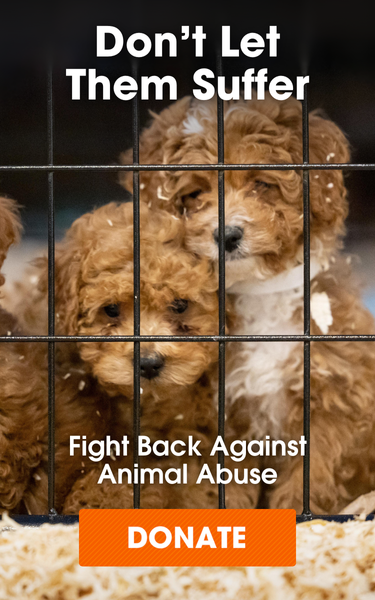Cruel commercial breeders want to maximize profit by producing the highest number of puppies at the lowest possible cost. Here’s how they do it.
Tiny Cages
More adult dogs to breed equals more puppies, which equals more money, so cruel breeders maximize space by keeping mother and father dogs tightly contained. They’re often kept in ramshackle outdoor pens, exposed to the elements, or in tiny, filthy cages for their entire lives. Caged dogs develop lesions and sores from constantly standing on uncomfortable wire flooring, and can get cut on the wire’s sharp points. Because the cages are usually stacked vertically, urine and feces rain down onto the dogs below. Dogs of all ages and sizes may be crammed in together, which can lead to stress, aggression and fighting. They aren’t taken on walks, and don’t get to play with toys or run around. They eat, sleep, relieve themselves and give birth in these cages. It’s the only reality they’ll ever know.
Poor Veterinary Care and Hygiene
Dogs, like people, need regular health care. However, health care can be costly, so dogs in cruel breeding facilities aren’t typically cared for by a veterinarian—not for vaccines, not for regular checkups, not when they’re sick and not for a teeth cleaning. Since breeding dogs aren’t seen by the public, they aren’t bathed and their hair is not brushed or cut. These dogs are left to suffer through painful injuries, broken bones, rotting teeth, dangerous levels of filth, festering mats that pull at their skin, and nails so long that they curl back into and pierce their paw pads.
The filthy conditions found in these facilities encourage the spread of diseases, especially among puppies with immature immune systems. Sometimes these illnesses can be life-threatening, painful and expensive to treat. Puppies often arrive in pet stores with health issues ranging from parasites to parvo to pneumonia. Because puppies are removed from their littermates and mothers at a very young age, they also can suffer from fear, anxiety and other lasting behavioral problems. Sometimes these issues don’t show up until people bring the puppy home, only to be confronted with unpredictable, expensive and oftentimes chronic medical problems.
Nonstop Breeding
Female dogs are treated like puppy-making machines. They are bred at every opportunity, without any rest time between litters, and when their bodies are so depleted that they can no longer produce puppies, they’re often abandoned or killed. The puppies are the lucky ones—they usually leave these horrible conditions by the time they’re eight weeks old. The parents of these puppies, however, are unlikely to make it out alive. Their only job is to produce puppies for as long as they live.
Disregard for Genetics
All puppies are cute, and unless you are an expert it can be tough to notice the physical differences between them. Unfortunately, a lot of serious medical and behavioral problems don’t reveal themselves until a puppy grows up—that’s why careful breeding is so important. Because quality is not a priority for cruel breeders, they don’t bother to remove medically compromised dogs from their breeding stock, resulting in generation after generation of dogs with unchecked hereditary defects. These frequently include heart disease, deafness, bone disorders like hip dysplasia, and blood and respiratory disorders.
Sources available upon request; contact [email protected] with specific questions about this content.

